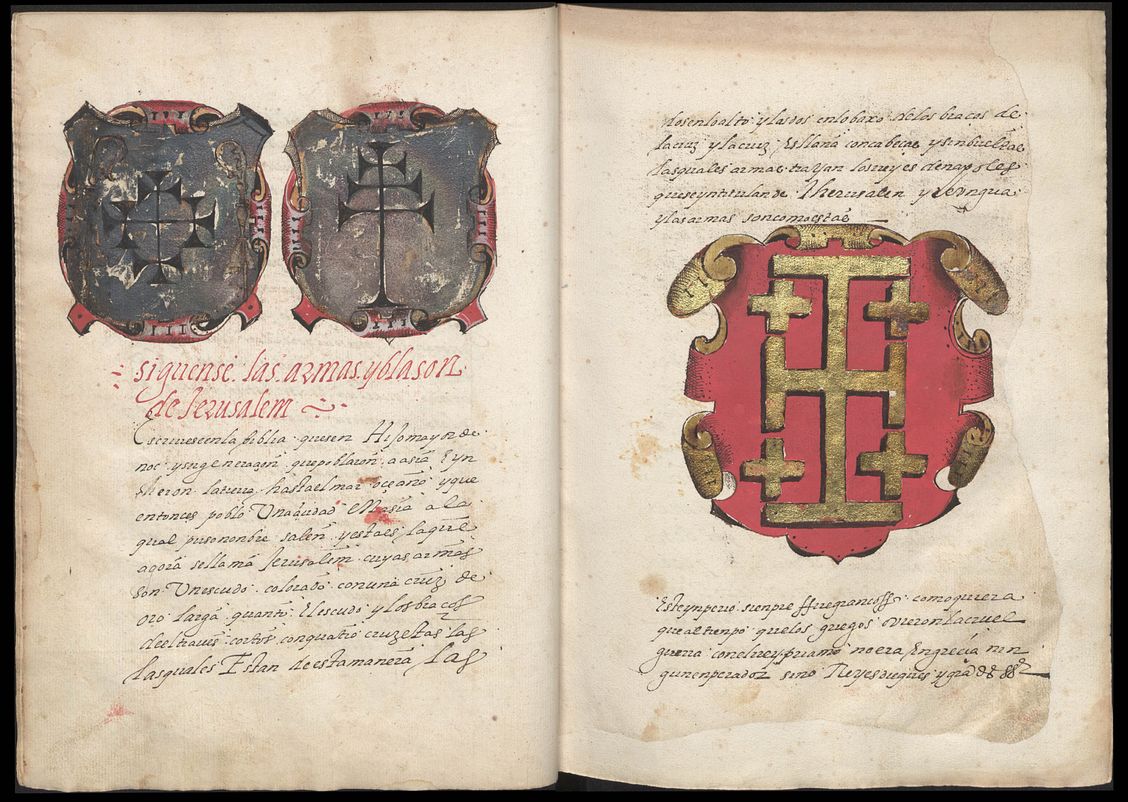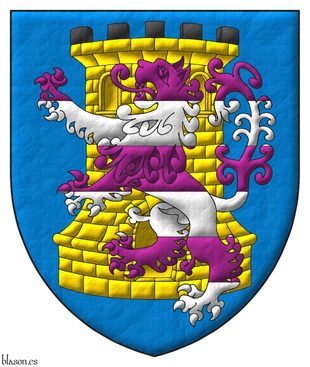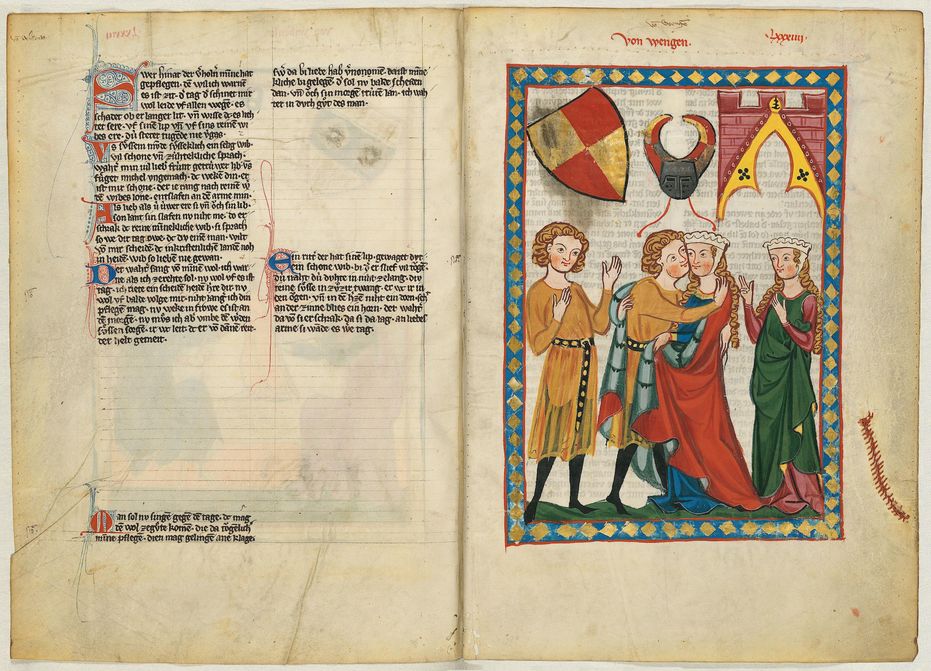
Crest, mantling and motto of Ignacio Pérez de Bartolome
Gules, a lion rampant Or, charged with a pallet gemel chequey Argent and Sable. Crest: Upon a helm with a wreath Or and Gules, a demi-dragon Or, supporting with its sinister a goldfinch speaking proper. Mantling: Gules doubled Or. Motto: «Quem Timebo» Sable with initial letters Gules over a scroll Argent.
Coat of arms designed by me, highlighted with lights and shadows, contoured in Sable, with an ogee external shape and with a freehand finish.
Blazon keywords: Gules, Or, Argent, Sable, One, Lion, Rampant, Charged, Pallet, Gemel, Chequey, Crest and mantling, Crest, Upon (wreath), Helm, Wreath, Demi, Dragon, Perched, Sinister, Goldfinch, Speaking, Proper, Mantling and Motto.
Style keywords: Outlined in sable, Illuminated, Ogee and Freehand.
Classification: Personal, Created, Boa and Coat of arms.
Bearer: Pérez de Bartolome, Ignacio.


![Ver [Galdiano L.; Century XVII] en referencias bibliográficas. Libro abierto, hojas de plata, filo de oro, guardas de gules, tapas de sable.](../css/Libro.Bibliografia.png)
Galdiano L.; Century XVII
Anonymous, «Arms and Lineages of Spain», Lázaro Galdiano Foundation, call number 405, manuscript, illustrated, 330 pages, 29 x 22 centimeters, century XVII.
Content and notes
This manuscript contains heraldic descriptions and illustrations of coats of arms, with a coat of arms at the end of each lineage. The coats of arms are painted at the end, and the title of the next lineage is written so close, sometimes physically attached, that one might believe that the title under the coat of arms belongs to the lineage of the coat of arms, when it is actually the coat of arms of the previous lineage. The initial index occupies 20 pages, then the folios are numbered r, recto, up to 194, folio 195 is numbered, its title is «of the Medranos» and it contains an unusual coat of arms, by another hand and without tinctures, folio 196 is numbered and blank, and the final 14 folios are written in another style, and they are a small compendium of heraldic concepts. I understand that the Medrano family might have owned this manuscript for a time and added their lineage at the end of this armorial.
Physical condition and binding
Some leaves have been restored and reinforced at the margins, and the manuscript is in good condition. There is an annotation in manuscript on the verso of the first guard leaf: «8, 1500, F».
A dry stamp is present on the second guard leaf: «Obrador De Encuadernaciones De Antonio Menard. 15 Cervantes 15 Madrid». The manuscript is bound in vellum with a gilded top edge.
Manuscript index
- Alphabetical table of lineages.
-
Armorial of kings:
- Of the arms of Prester John.
- Follow the arms and blazon of Jerusalem.
- Of the branches of the Kingdom of Cyprus and its King.
- Arms of the German Empire.
- Of the King of Hungary.
- The arms of Frisia and why it lost the name of Kingdom.
- Bohemia.
- Arms of the King of Poland and León.
- Of the kingdom of Sweden and Gothia.
- Of the kingdom of Norway.
- Of the King of Gelandia.
- Of the King of Scotland.
- Arms of England.
- Of the King of Hibernia.
- Arms of Rome.
- Arms of the King of Naples.
- Of the Duke of Milan.
- Of the King of Sicily.
- Of the King of France.
- Those who populated Spain are written.
- Of the Kings of Navarra.
- Of the King of Aragón.
- Of the King of Portugal.
- How the kings of Castilla began.
-
Armorial of lineages:
- Of the Manuels.
- Of the De la Cerda.
- Of the Enríquez.
- Of the Duke of Va Hermosa Don Alonso de Aragón.
- Of the Castillas.
- Of the Guzmanes.
- Of the Flores.
- Of the Ponces de León.
- Of the Carrillos.
- Of the Manriques.
- Of the De Albornoz.
- Of the Riveras.
- Of the Portugals.
- Of the Haros.
- Of the Lara lineage.
- Of the Guevaras.
- Of the Mendozas.
- From where the Hurtados come.
- Of the foundation and surname of Ayala.
- Of the Velascos.
- Of the De Castros.
- Of the Herreras.
- Of the De la Vegas.
- Of the De Tovars.
- Of the Sarmientos.
- Of the Estunigas.
- Of the Añayas.
- Of the Cerezos.
- Of the Heredias.
- Of the Aguilars.
- Of the Pachecos.
- Of the Osorios lineage.
- Another difference of arms.
- Pimentels.
- Of the Avellanedas.
- Of the Bracamontes.
- Of the Cueva.
- Of the Toledos.
- Another difference of arms of Toledo from the Garcías.
- Of the Barrosos.
- Of the Silvas.
- Of the Palomeques.
- Of the Gaitanes.
- Of the Gudiels.
- Of the Sandovals.
- Of the Niños.
- Of the Cervatos.
- Of the Fonsecas.
- Of the Coroneles.
- Of the Avalos.
- Of the Lunas.
- Of the Torquemadas.
- Of the Carvajales.
- Of the Rivadeneiras.
- Of the Padillas.
- Of the Valderrábanos.
- Of the Aguayos.
- Of the Zapatas.
- Of the Mirandas.
- Of the De Acuñas.
- Of the Arellanos.
- Of the Castañedas.
- Of the Quiñones.
- Of the Cornados.
- Of the Cervantes.
- Of the Loaysas.
- Of the Cisneros.
- Of the Dazas.
- Of the Córdobas.
- Of the Matas.
- Of the Aceves.
- Of the Cuellos.
- Of the Villarrueles.
- Of the De Biveros.
- Of the De Rojas.
- Of the De Orozcos.
- Those called from Bizcaya.
- Of the Sorvas.
- Of the Maldonados.
- Of the Fajardos.
- Of the Contreras.
- Of the Moscosos.
- Of the Mejías.
- Of the Sosas.
- Of the Figueroas.
- Of the Barahonas.
- Of the Montoyas.
- Of the Alarcóns.
- Of the La Torre.
- Of the Ludos.
- Of the Moyas.
- Of the Ángulos.
- Of the Calatayuds.
- Of the Gaonas.
- Of the Mendaños.
- Of the Beneros.
- Of the Londoños.
- Of the Quevedos.
- Of the Ulloas.
- Of the Quirogas.
- Of the Liras.
- Of the Meneses.
- Of the Girones.
- Of the constable Miguel Lucas.
- Of the Prados.
- Of the Salazars.
- Of the Solórzanos.
- Of the Cárdenas.
- Of the Biedmas.
- Of the Obregóns.
- Of the Bustos.
- Of the Almansas.
- Of the Puerto Carreros.
- Of the Sartes.
- Of the Carates.
- Of the Aljofríns.
- Of the Barrientos.
- Of the Reinosos.
- Of the Locanas.
- Of the Chacones.
- Of the Pantojas.
- Of the Carranzas.
- Of the Pereas.
- Of the Vanegas.
- Of the Lujanes.
- Of the Calderones.
- Of the La Cadena.
- Of the Delgadillos.
- Of the Clavijos.
- Of the Grajedas.
- Of the Ávila.
- Of the Lisones.
- Of the De Mesas.
- Of the Las Ruelas.
- Of the Rapados.
- Of the Villandrandos.
- Of the Luzones.
- Of the Torres.
- Of the De Soliez.
- Of the Herrezuelos.
- Of the Pavía.
- Of the Berrios.
- Of the Baruas.
- Of the Benavides.
- Two differences of arms.
- Of the Narváez.
- Of the Robles.
- Of the De Ñero.
- Of the Mojicas.
- Of the Bacanes.
- Of the Bastoncillos.
- Of the Bocanegras.
- Of the Castillos.
- Of the De Cañizares.
- Of the Cerezuela.
- Of the Dorantes.
- Of the De Estrada.
- Of the Escobares.
- Of the Salcedos.
- Of the De Inestrosa.
- Of the De Isla.
- Of the Illanes.
- Of the Jaravas.
- Of the Oñez.
- Of the Cuadrados.
- Of the Pardos.
- Of the Penalosas.
- Of the Porras.
- Of the Muñizes.
- Of the Ruecos.
- Of the Sotos.
- Of the Romos.
- Of the Salcedos.
- Of the Tenorios.
- Of the Valdeses.
- Of the Vallejos.
- Of the Villagómez.
- Of the Bargas.
- Of the Verdejos.
- Of the Marinos.
- Of the Morales.
-
Added lineage and coat of arms:
- Of the Medranos.
-
Compendium of heraldic concepts:
- First preamble.
- The rule of heraldry follows.
- Second preamble.
- Third preamble.
- Final fourth preamble.
- The meaning of gold.
- The meaning of silver.
- The meaning of blue.
- The meaning of gules, which is red.
- Sable, which is black.
- The meaning of vert, which is green.
- The meaning of purpure, which is purple.
Bibliographical reference of century XVII.
Classification: Manuscript, Armorial roll, Castilian language and In color.
The author is anonymous.
Bibliographical reference mentioned in the following article:
Internal resources: GaldianoLXVII.ArmasLinajesEspaña.pdf PDF format.


Jean Mortés, schema 1x2
Azure, a tower Or, embattled and masoned Sable, overall a lion rampant barry Purpure and Argent.
Coat of arms of Jean Mortes from Brittany, France, emblazoned by me in 2 steps: an outline drawing and flat colors and metals.
Blazon keywords: Azure, Or, Sable, Argent, Purpure, One, Tower, Embattled, Masoned, Overall, Lion, Rampant and Barry.
Style keywords: Outlined, Outlined in sable and Plain tincture.
Classification: Personal, Interpreted, Schema, Boa and Coat of arms.
Bearer: Mortés, Jean.


Jean Mortés, schema 1x3
Azure, a tower Or, embattled and masoned Sable, overall a lion rampant barry Purpure and Argent.
Coat of arms of Jean Mortes from Brittany, France, emblazoned by me. The image illustrates my process in 3 steps: delineation, plain colors and metals, and lights and shadows.
Blazon keywords: Azure, Or, Sable, Argent, Purpure, One, Tower, Embattled, Masoned, Overall, Lion, Rampant and Barry.
Style keywords: Outlined, Outlined in sable, Plain tincture and Illuminated.
Classification: Personal, Interpreted, Schema, Boa and Coat of arms.
Bearer: Mortés, Jean.


Mortés, Jean
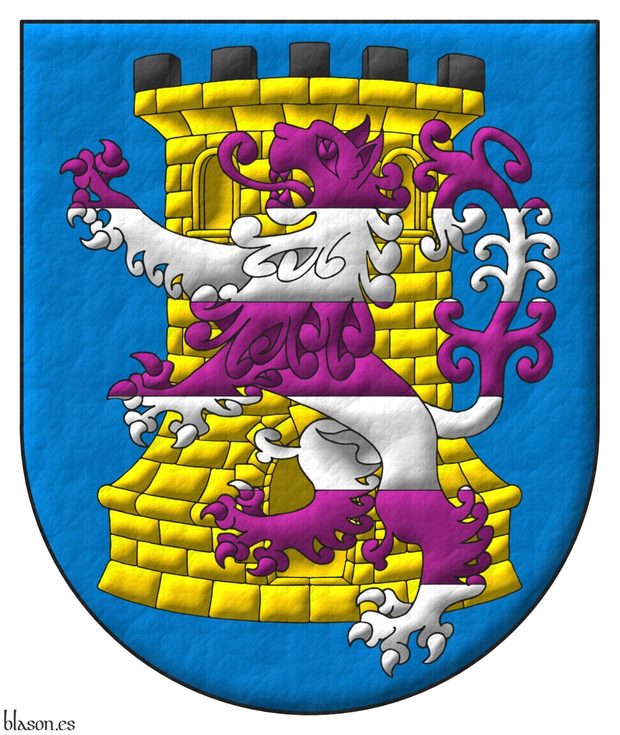
Azure, a tower Or, embattled and masoned Sable, overall a lion rampant barry Purpure and Argent.
Escudo de azur, una torre de oro, almenada y mazonada de sable, brochante sobre el todo un león rampante fajado de púrpura y plata.
Coat of arms interpreted by me, highlighted with lights and shadows, outlined in Sable, with a semi-circular external shape and with a leather finish.
Coat of arms of Jean Mortes from Brittany, France, emblazoned by me with a shield with a semi-circular base.
Blazon keywords: Azure, Or, Sable, Argent, Purpure, One, Tower, Embattled, Masoned, Overall, Lion, Rampant and Barry.
Style keywords: Outlined in sable, Illuminated, Semi-circular and Leather.
Classification: Personal, Interpreted, Boa and Coat of arms.
Bearer: Mortés, Jean.


Jean Mortés, plain tincture
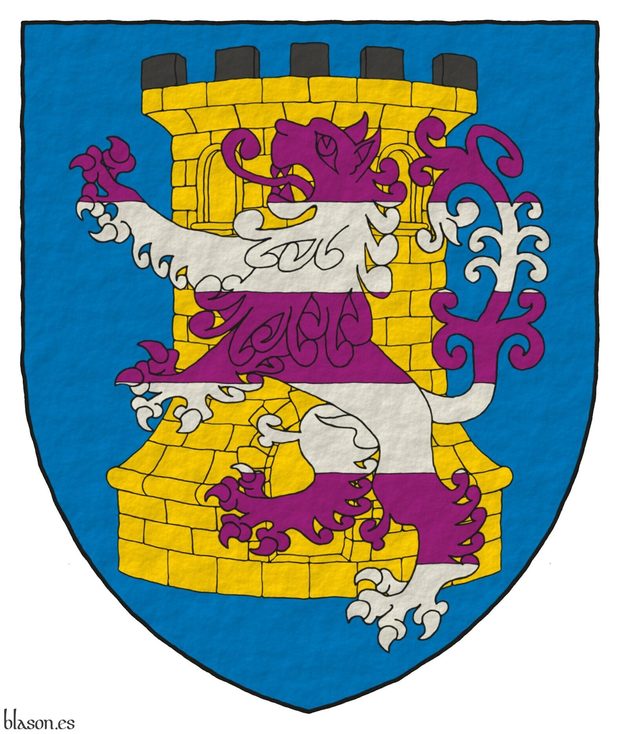
Azure, a tower Or, embattled and masoned Sable, overall a lion rampant barry Purpure and Argent.
Arms interpreted by me, in plain tinctures, contoured in Sable, and with a texturized finishing.
Coat of arms of Jean Mortes from Brittany, France, emblazoned by me.
Blazon keywords: Azure, Or, Sable, Argent, Purpure, One, Tower, Embattled, Masoned, Overall, Lion, Rampant and Barry.
Style keywords: Outlined in sable and Plain tincture.
Classification: Personal, Interpreted, Boa and Coat of arms.
Bearer: Mortés, Jean.


Jean Mortés, structured and parallel blazons
Coat of arms of Jean Mortes from Brittany, France, emblazoned by me with a heater shape, and with the blazon written in English and Castilian in a structured way to observe the parallelism between both forms.
Blazon keywords: Azure, Or, Sable, Argent, Purpure, One, Tower, Embattled, Masoned, Overall, Lion, Rampant and Barry.
Style keywords: Outlined in sable, Illuminated, Pointed and Leather.
Classification: Personal, Interpreted, Structured and parallel blazons, Boa and Coat of arms.
Bearer: Mortés, Jean.


![Ver [Manesse; 1315] en referencias bibliográficas. Libro abierto, hojas de plata, filo de oro, guardas de gules, tapas de sable.](../css/Libro.Bibliografia.png)
Manesse; 1315
Anonymous, «Große Heidelberger Liederhandschrift», University Library of Heidelberg, call number Codex Palatinus Germanicus 848, 852 pages, numbered from folio 1 to folio 426 v and r each side, parchment, 35.5 x 25 centimeters, manuscript in Middle High German, circa 1300-1340.
Von Wengen, folio 300r
Contents
The «Codex Manesse», also known as the «Great Heidelberg Book of Songs», Codex Palatinus Germanicus 848, is the most comprehensive collection of ballads and epigrammatic poetry in Middle High German. The manuscript contains almost 6000 verses from 140 poets, making it a key source for medieval German lyrics. The manuscript is written in gothic letters by several hands and is famous for its glorious colorful full-page miniatures, each dedicated to one of the 137 poets. The miniatures illustrate the poets in idealized, courtly scenes and are considered a significant document of Gothic illumination from the Upper Rhine region. It is not an armorial, but some of the illustrations feature coats of arms, including helmets with their crests.
The Manesse family
This codex was completed around the year 1304, although some parts may have been added later, up until the mid-14th century. Therefore, an approximate date of 1315 is often used as a general reference for the codex in its most complete state. The author of the codex is not known in the modern sense of the word. However, its compilation and sponsorship are attributed to the Manesse family, a patrician family from Zurich, particularly Rudolf II Manesse and his son Rudolf III Manesse, who likely commissioned and financed the creation of the codex.
Ownership history
The early history of the manuscript is not well-documented, by the end of the 16th century, it was in the possession of the Swiss Calvinist Johann Philipp von Hohensax. In 1607, the codex was claimed by the Prince Elector Frederick IV and brought to Heidelberg. During the Thirty Years' War, the manuscript was taken into exile to avoid capture. After the death of Frederick V in 1632, the manuscript was auctioned and eventually found its way to the Royal Library in Paris, where it remained for 230 years. In 1888, the manuscript was returned to Germany after a complex exchange deal orchestrated by bookseller Karl Ignaz Trübner. It is now preserved in the University Library of Heidelberg.
Condition and preservation
The turbulent history of the «Codex Manesse» has left its mark, with many miniatures showing damage from color abrasions and ink corrosion. Due to its fragile condition, the original codex is kept in an air-conditioned safe and is rarely exhibited. Facsimile editions have been produced over the years, including a full-facsimile published by Insel Verlag in 1925-1927.
Exhibitions and legacy
The «Codex Manesse» has been the subject of numerous exhibitions, including a comprehensive display in 1988 and another during the 625th anniversary of the University of Heidelberg in 2010-2011. It remains one of the most precious treasures of the University Library of Heidelberg and a cornerstone in the study of medieval German literature and art.
Bibliographical reference of century XIV.
Classification: Manuscript, German language and In color.
Author: anonymous.
External links:
Internal resources: Manesse1315.pdf Armorial in PDF format.

Continue with: Jose Manuel Gutiérrez Benítez, plain tincture.
-
Language
-
Categories of heraldry
-
Divisions of the field
- Without divisions
- Party per pale
- Party per fess
- Party per bend
- Party per bend sinister
- Tierce
- Tierce sinister
- Tierced per pale
- Tierced per fess
- Tierced per bend
- Tierced pallwise inverted
- Quarterly
- Quarterly per saltire
- Gyronny
- Party per fess, the chief per pale
- Party per pale, the sinister per fess
- Party per fess, the base per pale
- Party per pale, the dexter per fess
- Chapé
- Chaussé
- Embrassé
- Contre-embrassé
- Party per chevron
- Enté
- Enté en point
- Flanched
-
Metals
-
Colours
-
Furs
-
Other tinctures
-
Ordinaries and sub-ordinaries
-
Diminutives of the ordinaries
-
Geometric charges
-
Composite ordinaries
-
Inanimate charges from Nature
Atom, Crescent, Diamond, Emerald, Estoile, Increscent, Lightning flash, Moon, Mount, Mullet, Mullet of four points, Orbital, Plough of Ursa Major, Rainbow, Ray of the sun, River, Sea, Snowflake, Sun, Sun in splendour, Sun of May, Trimount and Water.
-
Vegetal charges from Nature
Acorn, Apple, Apple tree, Ash, Bluebonnet, Camellia, Chrysanthemum, Cinquefoil, Cornflower, Dogwood flower, Double rose, Elm, Fleur de lis, Flower, Holm oak, Hop cone, Kapok tree, Laurel, Lily, Linden, Lotus flower, Madonna lily, Oak, Olive tree, Palm tree, Pomegranate, Poplar leaf, Rose, Shamrock, Sunflower, Thistle, Tree, Tulip, Vine and Wheat.
-
Animal charges from Nature
Badger, Bald eagle, Barbel, Barn owl, Bear, Beaver, Beetle, Bighorn sheep, Blackbird, Boar, Brach hound, Bull, Doe, Dog, Dolphin, Dove, Eagle, Elephant, Falcon, Fish, Flame, Fly, Fox, Frog, Goat, Goldfinch, Goose, Heron, Horse, Hummingbird, Jaguar, Lark, Leopard, Lion, Lion passant, Lion rampant guardant, Lioness, Lynx, Male figure, Martlet, Merino ram, Owl, Panther, Parrot, Peacock, Pelican, Pelican in her piety, Puffin, Quetzal, Raven, Roe deer, Rooster, Savage, Seagull, Serpent, She-wolf, Stag, Starling, Talbot, Tyger, Vulture, Warren hound and Wolf.
-
Parts of natural charges
Arm, Beak, Branch, Caboshed, Chest, Claw, Covert, Dorsal fin, Eagle claw, Ermine spot, Escallop, Feather, Foot (palmiped), Foreleg, Forepaw, Hand, Head, Heart, Hoof, Leaf, Neck, Ostrich feather, Palm frond, Paw, Roe deers' attires, Shoulder, Sprig, Stags' attires, Stem, Swallow-tail, Tail, Tail addorsed, Tail fin, Talon, Tooth, Trunk, Trunk (elephant), Two hands clasped, Two wings in vol, Udder, Wheat spike, Wing and Wrist.
-
Artificial charges
Ace of spades, Anchor, Anvil, Arch, Arm vambraced, Armillary sphere, Arrow, Axe, Bell, Bell tower, Beret, Bonfire, Book, Bookmark, Bow, Bridge, Broken, Buckle, Cannon, Cannon dismounted, Cannon port, Canopy roof, Carbuncle, Castle, Celtic Trinity knot, Chain, Chess rooks, Church, Clarion, Clay pot, Closed book, Club, Comb, Compass rose, Conductor's baton, Cord, Covered cup, Crozier, Crucible, Cuffed, Cup, Cyclamor, Dagger, Double vajra, Drum, Ecclesiastical cap, Fanon, Federschwert, Fleam, Four crescents joined millsailwise, Galician granary, Garb, Gauntlet, Geometric solid, Grenade, Halberd, Hammer, Harp, Host, Hourglass, Key, Key ward, Knight, Knot, Lantern, Letter, Line, Loincloth, Menorah, Millrind, Millstone, Millwheel, Monstrance, Mortar, Mullet of six points pierced, Nail, Non-classic artifact, Norman ship, Number, Oar, Oil lamp, Open book, Page, Pair of scales, Parchment, Pestle, Piano, Plough share, Polish winged hussar, Port, Portcullis, Potent, Quill, Ribbon, Rosette of acanthus leaves, Sabre, Sackbut, Sail, Scroll, Scythe, Sheaf of tobacco, Ship, Skirt, Spear, Spear's head, Stairway, Star of David, Step, Sword, Symbol, Tetrahedron, Torch, Tower, Trident, Trumpet, Turret, Two-handed sword, Wagon-wheel, Water-bouget, Wheel, Winnowing fan and With a turret.
-
Immaterial charges
Angel, Archangel, Basilisk, Dragon, Dragon's head, Garuda, Golden fleece, Griffin, Heart enflamed, Mermaid, Our Lady of Mercy, Ouroboros, Paschal lamb, Pegasus, Phoenix, Sacred Heart of Jesus, Saint George, Sea-griffin, Trinity, Triton, Unicorn, Winged hand and Wyvern.
-
External elements
-
Heraldic creations
-
References
-
Formats
-
Keywords on this page
Port and windows, Chequey, Proper, Embattled, Engrailed, Pointed, Armorial roll, Azure, Bibliography, Structured and parallel blazons, Boa, Bordure, Overall, Wreath, Head, Chevron, Speaking, Charged, Castle, Upon (wreath), Crest, Compony, Ogee, Created, Four, Outlined, Outlined in sable, In color, Coat of arms, Schema, Barry, Personal, Gules, Illuminated, Interpreted, Lion, Manuscript, Masoned, Semi-circular, Mortés, Jean, Or, Leather, Argent, Purpure, Rampant, Sable, Plain tincture, Tower and One.


